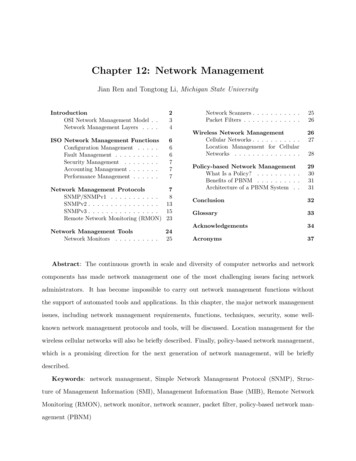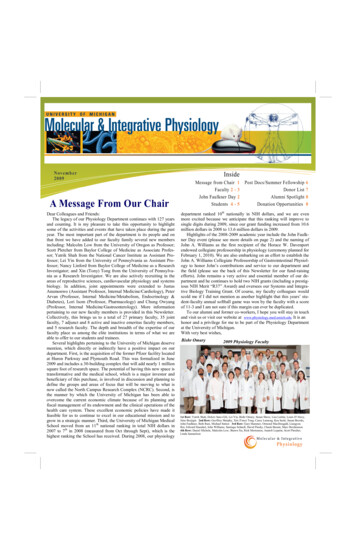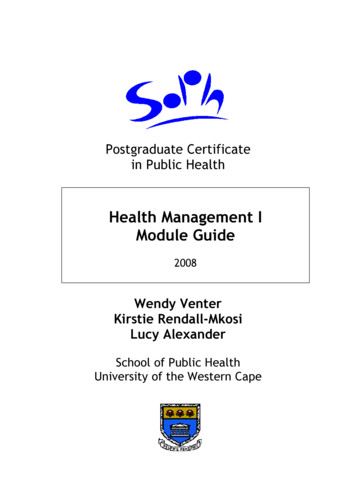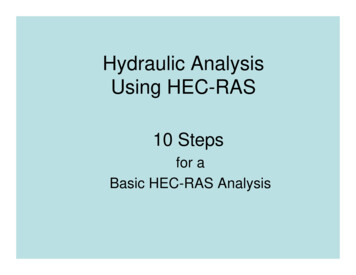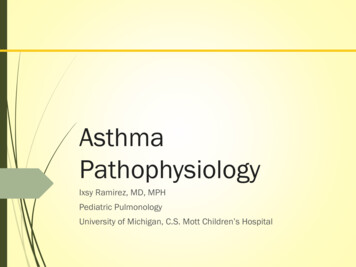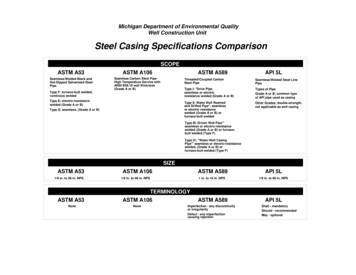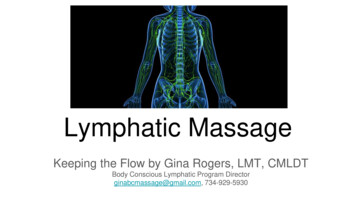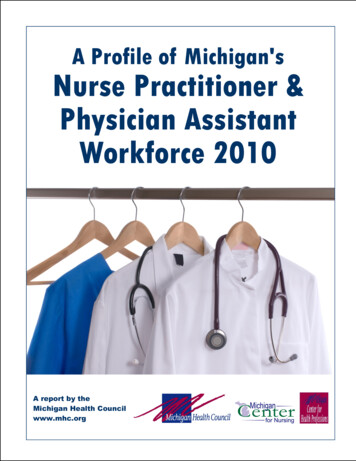
Transcription
A Profile of Michigan'sNurse Practitioner &Physician AssistantWorkforce 2010A report by theMichigan Health Councilwww.mhc.org
October 27, 2010Dear Healthcare Partner,Healthcare reform will affect the health workforce dramatically. The Michigan Health Council’s Center forNursing and Center for Health Professions have focused our attention on the challenges facing the healthcareworkforce in Michigan. To develop a picture of the current healthcare workforce providing much of Michigan’sprimary care and to plan for the future, Public Sector Consultants was commissioned to develop a profile ofPhysician Assistants and Nurse Practitioners in Michigan. The attached profile is a partner to the 2009Physician Profile as well as the American Association of Medical Colleges (AAMC) Center for Workforce Studiesreleased in June 2010 an analysis detailing the physician shortage that will be exacerbated with the expansionof coverage under health reform law and the aging of the population.The AAMC projects a shortage of 45,000 primary care physicians and 46,000 surgeons and medical specialistsIN THE NEXT DECADE nationwide which doubles previous estimates. The Department of Health and HumanServices has released funding to create an additional 889 primary care residency slots. While helpful, thisnumber does little to address the impending shortage of primary care physicians and doesn’t begin to addressthe shortage of specialty physicians.Often Physician Assistants and Nurse Practitioners are factored in as collaborating health care team membersin the delivery of care. The Profile of NP/PA’s in Michigan is very interesting when looking at the health careteam and planning for the Michigan’s future healthcare needs. Particularly interesting is the number of PA’s inspecialty practice (65%) versus primary care (35%) in Michigan.Because specific information about nurse practitioners was not available for this profile, a study by PublicSector Consultants for the Center for Nursing at the Michigan Health Council is now in the field and will bereported in January 2011. It will focus on where Nurse Practitioners practice, whether there is employmentsite movement in the profession and other issues germane to NP’s in Michigan. This study will be sent to youand posted on the Michigan Health Council website (www.mhc.org) under top tab Survey/Articles in midDecember.It is our hope that this profile will create a better picture of the ability of the PA/NP workforce to addressshortage needs in Michigan.Please send any comments on the profiles to me – anne@mhc.org. Let’s all work together to build an effectiveand adequate health workforce in Michigan.Sincerely,Anne Rosewarne, PresidentMichigan Health CouncilMichigan Health Council 2410 Woodlake Drive Okemos, Michigan 48864 Ph 517-347-3332 Fax 517-347-4096
Nurse Practitioner/PhysicianAssistant ProfileOctober 2010Prepared forMichigan Health CouncilOkemos, MichiganPrepared byPublic Sector Consultants Inc.Lansing, Michiganwww.pscinc.com
INTRODUCTIONThis profile has been developed for the Center for Health Professions at the MichiganHealth Council. It provides information on nurse practitioners (NPs) and physicianassistants (PAs) currently practicing in Michigan and on issues that may affect supplyand demand in these professions. This information is being provided to helppolicymakers create strategies to address health care workforce needs in Michigan.The professions of nurse practitioner and physician assistant developed in the mid-1960s,in response to a shortage of physicians providing primary care services in underservedrural and inner-city areas. Since then, education programs throughout the nation havetrained more of these health care professionals and education standards have evolvedfrom undergraduate training to master’s degree programs. The success of these healthcare professions spurred the federal government to fund formal training programsthrough statutory changes in the Public Health Service Act that allow tuitionreimbursement for students in these programs. During the 1990s, perceptions thatprimary care physicians were in short supply renewed interest in nurse practitioner andphysician assistant training. The number of practicing NPs tripled from 30,000 in 1990 to90,000 ten years later.1 The American Academy of Nurse Practitioners estimated 135,000NPs practicing nationwide in 2010.2 Similarly, the number of PAs climbed from fewerthan 20,000 in 1990 to almost 60,000 in 2000. By 2009, the American Academy ofPhysician Assistants estimated the number of PAs in practice at almost 74,000.3Nurse PractitionersIn Michigan, registered nurses (RNs) wishing to practice as and call themselves nursepractitioners must obtain nurse specialty certification from the state. A valid RN licenseand proof of certification from a national certifying agency is required for statecertification. The State of Michigan accepts certification from several national certifyingbodies for nurse practitioners. As of January 2010, 6,486 RNs were certified as advancedpractice registered nurses (APRNs); of those, more than half (3,778) were nursepractitioners.4 In order to maintain this certification, an RN must practice at least parttime; therefore, all certified nurse practitioners in the state are active (that is, working atleast part-time). According to the American Academy of Nurse Practitioners, 95 percentof nurse practitioners nationwide are female: the average nurse practitioner is 48 years1Richard Cooper, New Directions for Nurse Practitioners and Physician Assistants in the Era of PhysicianShortages, Academic Medicine 82, no. 9 (2007): 827–828.2American Academy of Nurse Practitioners (AANP), Nurse Practitioner Facts, available online 603-8949-710A287E0B32/0/NPFacts2010.pdf(accessed 5/14/10).3American Academy of Physician Assistants, FAQ, available online at http://www.aapa.org/about-pas/faqabout-pas (accessed 5/14/10).4The others were nurse midwives or nurse anesthetists. The Michigan Board of Nursing administrativerules list the following certification organizations for nurse practitioners, nurse midwives, and nurseanesthetists: American Association of Nurse Anesthetists, American College of Nurse MidwivesCertification Council; American Nurses Credentialing Center (ANCC) Certification; National CertificationBoard of Pediatric Nurse Practitioners and Nurses; National Certification Corporation for Obstetric,Gynecologic, and Neonatal Specialties; American Academy of Nurse Practitioners; Oncology NursingCertification CorporationNurse Practitioner/Physician Assistant ProfileOctober 20101
old and has been in practice for 10.5 years.5 In Michigan, the average age of nursepractitioners is 49.6Physician AssistantsIn order to practice in Michigan, physician assistants must obtain licensure from the state.To be licensed, applicants must show that they hold a degree from an accreditedphysician assistant education program and have passed the Physician Assistant NationalCertifying Exam (PANCE). As of January 2009 (the most recent data available), 3,176physician assistants were licensed. Of these, 93 percent are active in Michigan—workingat least part-time. About two-thirds (66 percent) of PAs renewing a license in 2008 and2009 were female, and more than half of PAs were under the age of 45.7 These data areconsistent with national figures. According to the most recent census from the AmericanAcademy of Physician Assistants, the average age of PAs is 41 and 66 percent of PAs arefemale.8SummaryExhibit 1 summarizes the gender and certification/licensure information for nursepractitioners and physician assistants in Michigan.EXHIBIT 1Certified Nurse Practitioners and Licensed Physician Assistantsin Michigan, January 2009NursepractitionersPhysicianassistantsTotal number certified/licensed in Michigan3,7783,176Total : Licensure data provided by MDCH; 2010; AAPA, 2009 Physician Assistant Census National Report, 2010;Public Sector Consultants Inc., MDCH Survey of Physician Assistants, 2008 and 2009.PRACTICE SPECIALTY AND SETTINGBoth of these professions arose to expand the availability of primary care services byincreasing the number of providers working closely with physicians in primary caresettings. Subsequently, however, NPs and PAs have branched into other areas of practice5AANP, Nurse Practitioner Facts.Data provided to PSC by the Michigan Department of Community Health (MDCH) Licensing Bureau,2010.7Public Sector Consultants Inc. (PSC), MDCH Survey of Physician Assistants, Survey Findings 2009(Lansing, Mich.: PSC, January 2010).8American Academy of Physician Assistants (AAPA), 2009 AAPA Physician Assistant Census NationalReport # CENS2009-01, January 2010, available online at http://www.aapa.org/images/stories/Data 2009/2009aapacensusnationalreport.pdf (accessed 5/14/10).62Nurse Practitioner/Physician Assistant ProfileOctober 2010
and are no longer found only in primary care settings. Many practice specialties nowhave care delivery teams that include NPs and PAs.Nurse PractitionersCollecting information on the specialty areas in which NPs practice is difficult. No singleentity collects this information for all active, certified nurse practitioners in the state.(The Michigan Center for Nursing at the Michigan Health Council will survey nursepractitioners in fall 2010 to get the answers to this and other questions.) Estimatessuggest that the bulk of nurse practitioners can be found in primary care specialties. TheMichigan Council of Nurse Practitioners (MICNP) maintains that 59 percent of nursepractitioners in the state practice in primary care settings.9 (The MICNP defines primarycare as family, adult, and pediatric general practice.) Nationally, the American Academyof Nurse Practitioners (AANP) maintains that approximately 76 percent of active nursepractitioners can be found in these primary care specialties. The AANP tracks specialtyinformation for its membership (see Exhibit 2).EXHIBIT 2Nationwide Distribution of Nurse Practitioners, by Specialty, 2009Nurse practitioner specialtyFamily MedicineAdult Primary CarePediatricsWomen’s HealthAcute CareGerontologyPsychiatry/Mental HealthNeonatologyOncologyPercentageof NPs49%189953321Average years ofpractice101113157129128SOURCE: American Academy of Nurse Practitioners National Nurse Practitioner Database, 2009.NOTE: Percentages do not equal 100 percent due to rounding.The six most frequently reported practice settings for NPs, according to a 2006 AANPmember survey, were private physician practice (32 percent); community and publichealth settings (10 percent); hospital outpatient clinics (10 percent); inpatient hospitals (9percent); a rural health setting (5 percent); and emergency or urgent care facilities (4percent).10Physician AssistantsAccording to the 2009 Michigan Department of Community Health Survey of PhysicianAssistants, about 35 percent of physician assistants in Michigan practice in four primary9Personal communication from Connie Knapper, Michigan Council of Nurse Practitioners (MICNP),February 22, 2010.10American Academy of Nurse Practitioners (AANP), AANP 2006 Membership Survey, available online 3C7-8375-C24E0744318A/0/2006MembershipSurvey.pdf (accessed 5/14/10).Nurse Practitioner/Physician Assistant ProfileOctober 20103
care specialties: family practice, general medicine, internal medicine, or pediatrics. Theremaining 65 percent of active physician assistants practice in other specialty areas (seeExhibit 3).EXHIBIT 3Distribution of Active Physician Assistants in Michigan, by Specialty, 2009SpecialtyPercentageSpecialtyFamily practiceEmergency medicineInternal medicine (General)Orthopedic surgeryCardiovascular diseaseHospitalistSurgery (General)22%1188644Allergy & c SurgeryPsychiatryUrologyDermatologyGeneral medicineNeurological surgeryGastroenterologyObstetrics & gynecologyOccupational medicineOncology/hematologyPediatricsPhysical medicine & rehabilitationRadiologyThoracic surgery33322222222AnesthesiologyCritical care medicineEndocrinologyNeurologyRheumatologyVascular surgeryInfectious diseasePreventive medicinePulmonary diseaseSports medicineOtherPercentage1%111111 1 1 1 1 1 100006SOURCE: Public Sector Consultants Inc., MDCH Survey of Physician Assistants 2009.NOTE: Percentages may not equal 100 percent due to rounding.When asked to identify their work settings, 52 percent of physician assistants respondedthat they worked in a physician’s office, 41 percent in a hospital inpatient setting, and 26percent in a hospital outpatient setting (see Exhibit 4). Percentages do not equal 100percent because one-third of all physician assistants work in more than one setting fortheir main employer.EXHIBIT 4Current Employment Settings of Physician Assistants, 2009Percentage of activephysician assistants in MichiganSettingPhysician’s office52%Hospital inpatient41Hospital outpatient26Nursing home/long-term care facility5Public/community health3PA education program2Home health care24Nurse Practitioner/Physician Assistant ProfileOctober 2010
SettingPercentage of activephysician assistants in MichiganHospice 1Other8SOURCE: Public Sector Consultants Inc., MDCH Survey of Physician Assistants 2009.NOTE: Percentages do not equal 100 percent because respondents were asked to mark “all that apply.”EDUCATIONNurse PractitionersNurse practitioners in Michigan hold a master’s degree in nursing, with either aspecialization in advanced practice nursing or a certificate in advanced practice nursing inaddition to a traditional master’s degree in nursing. Currently, ten schools in Michiganoffered programs in advanced practice nursing; two of those are transitioning to doctoralprograms in nursing practice. Based on the information from these schools, total annualgraduates have risen from 173 to 194 from 2005 to 2009.EXHIBIT 5Nurse Practitioner Graduates, Specialization inAdvanced Practice Nursing, 2005–2009Nurse practitioner program20052006200720082009Grand Valley State University2630141015Madonna University11109219Michigan State University2321161924Northern Michigan University**11***Oakland University11191415131101810University of Detroit-MercyNA6111414University of Michigan4227232529010912204227442348Saginaw Valley State UniversityUniversity of Michigan - FlintWayne State University12SOURCE: As reported by each school. NA No answer. GVSU and U-M Flint suspended new enrollments in 2008 andare changing the master’s program to a Doctor of Nursing Practice degree. **Northern Michigan University (NMU) admitsa new cohort every 3 years. ***NMU 2005 graduated 11 people from the 2002 cohort of 16 students.Physician AssistantsFive schools in Michigan offer master’s-level training programs for physician assistantsthat meet the requirements of the Michigan Task Force on Physician Assistants, a stateboard with statutory authority for regulating physician assistant training, licensure, anddiscipline. Based on the information made available from schools, an annual average of186 PAs has graduated from these programs from 2005 through 2009 (see Exhibit 6). Topractice, graduates of these programs must pass a certification exam from the NationalCommission on Certification of Physician Assistants. In Michigan, 68 percent of activephysician assistants have a master’s degree, 26 percent hold a bachelor’s degree, 4Nurse Practitioner/Physician Assistant ProfileOctober 20105
percent have completed an associate’s degree, and 3 percent do not hold a degree buthave received other PA training.11EXHIBIT 6Physician Assistant Graduates, Master’s Level, 2005–2009PA programCentral Michigan University200520062007200820094441404242Grand Valley State University2828282833University of Detroit-Mercy3329344036Wayne State University4747494648Western Michigan University2934363435SOURCE: As reported by each school.SCOPE OF PRACTICEScope of practice refers to the extent to which health care providers may render healthcare services and the extent to which they may do so independently. Scope of practice foreach health care profession is grounded in the education standards of the profession andis dictated by statute, administrative rules, and case law.Scope of practice can be defined through three main avenues. First, each professionalorganization develops and maintains practice standards for professional members, whichbroadly outline the standards that those professionals are expected to follow. Secondly,state statute, case law, and administrative rules define the legal parameters forprofessional practice. Finally, Medicare, Medicaid, and insurers have standards thatdictate services for which they will provide reimbursement for each health professional.The different definitions of the scope of practice for a health profession reflected in thesethree avenues have led to conflicting interpretations among health professionals. Sufficeit to say that there is no general agreement on the scope of practice for severalprofessions. These conflicting interpretations extend to prescribing authority in Michigan,which is regulated separately from scope of practice in statute and is discussed separatelyon page 9.Nurse PractitionersThe American Academy of Nurse Practitioners publishes Standards of Practice for NursePractitioners. These standards are not binding and do not hold the force of law; they aregenerally accepted practice standards in the profession. Practice standards defined by theAcademy include: Process of care, which encompasses health status assessment, diagnosis, assistingwith treatment plan development, treatment plan implementation, and follow-up andevaluation of patient status. Care priorities, which include patient and family education, facilitation of patientparticipation in self-care, promotion of optimal health, provision of continually116PSC, MDCH Survey of Physician Assistants 2009.Nurse Practitioner/Physician Assistant ProfileOctober 2010
competent care, facilitation of entry into the health system, and promotion of a safeenvironment.Collaborative responsibilities, which include participating in the provision of healthand medical care with professional colleagues.Accurately documenting patient status and care.Patient advocacy.Assuring quality and continued competency in care provision.12The Michigan Public Health Code defines “practice of nursing” as “the systemicapplication of specialized knowledge and skills derived from the biological, physical, andbehavioral sciences, to the care, treatment, counsel, and health teaching of individualswho are experiencing changes in the normal health processes or who require assistance inthe maintenance of health and the prevention or management of illness, injury, ordisability.”13 Because NPs are licensed as RNs, their scope of practice is broadly definedthrough this statute; no separately defined scope of practice exists for NPs in Michiganlaw. RNs are licensed to practice without direct physician supervision within this scopeand given statutory authority to supervise less skilled personnel to perform delegatednursing duties. However, some activities are expressly prohibited by law, whichconsequently limits NP scope of practice. These activities include practicing medicine,which is defined as “the diagnosis, treatment, prevention, cure, or relieving of a humandisease, ailment, defect, complaint, or other physical or mental condition, by attendance,advice, device, diagnostic test, or other means, or offering, undertaking, attempting to do,or holding oneself out as able to do, any of these acts.”14 Prohibited activities also includeperforming surgeries or invasive procedures and ordering physical therapy for patients.Each state regulates scope of practice for health professionals differently, so NPs in otherstates may have more or less autonomy than they ha
primary care and to plan for the future, Public Sector Consultants was commissioned to develop a profile of Physician Assistants and Nurse Practitioners in Michigan. The attached profile is a partner to the 2009 Physician Profile as well as the Ame
